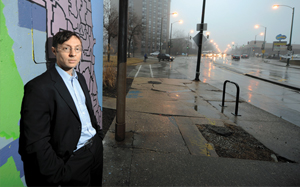Test of violence
"Urban-problems guy" Jens Ludwig uses clinical trial rigor to identify anticrime programs with the most promise.
By Brooke E. O’Neill, AM’04
Photography by Dan Dry
On September 1, 2008, one day before starting fourth grade, Nequiel Fowler, 10, was killed by a stray bullet near her South Chicago home. She’d been tying her five-year-old sister’s shoe when she got caught in gang crossfire. Her death came on the heels of a violent 2007–08 school year that saw 23 Chicago Public Schools students slain by firearms.

U of C Crime Lab director Ludwig says the annual social cost of Chicago gun violence is $2.5 billion.
It’s a sobering situation with no clear solution, says crime-policy specialist Jens Ludwig. Because programs to reduce violent crime are rarely tested scientifically, “we don’t really know much about what works and what doesn’t,” says the McCormick Foundation Professor of Social Service Administration, Law, and Public Policy in the Harris School and the SSA. When crack cocaine fueled a violent-crime wave in the mid-1980s, cities tried to “invent their way out of the violence problem” with approaches like New York’s CompStat, which used crime-data–mapping technology and gave precinct commanders more authority to target troubled areas. When crime rates plummeted in the 1990s, people credited local innovations, even though cities without new programs witnessed the same decline. Now, says Ludwig, “you have lots of people running around the country making claims that they have come up with the Salk vaccine for violence,” without conclusive evidence to prove it.
Ludwig puts such claims to the test. As director of the University of Chicago Crime Lab, a nationwide network of researchers, he wants to carefully evaluate programs intended to diminish crime. A self-described “urban-problems guy” whose work spans gun policy, early-childhood education, and public housing, Ludwig sees violence as one facet of the interconnected challenges low-income, urban families face. Take the average 1990s Cook County juvenile detainee, he says. Raised in a poverty-stricken neighborhood, often plagued with mental-health problems, and functioning significantly below grade level, is that kid “a health problem? A crime problem? An education problem?” asks Ludwig. “I don’t know how to isolate that in any particular box.” Acknowledging that these issues are connected, he says, puts researchers closer to ameliorating them.
Launched in April 2008, the Crime Lab reflects that philosophy, covering a wide spectrum of projects, including a Milwaukee experiment to help prisoners jailed for violent offenses re-enter society and an assessment of Chicago public housing’s effect on youth crime.
Also on the roster: a partnership with the City of Chicago to identify and develop effective youth gun-violence–prevention strategies. The Crime Lab’s first report was released in March, and it pegged the social cost of Chicago gun violence at an annual $2.5 billion. It also noted that most Cook County Juvenile Detention Center residents suffer at least one mental illness, and that the average juvenile inmate scored lower on a vocabulary test than 95 percent of the general youth population.
A key goal of every Crime Lab study, says Ludwig, is to “generate evidence that’s as rigorous as any clinical trial in medicine.” One way to do so is to evaluate real-world programs that select participants via random lottery, which creates an experimental group and a control group for researchers to compare. The U.S. Department of Housing and Urban Development’s Moving to Opportunity Program, for example, moved low-income families selected by lottery in Baltimore, Boston, Chicago, Los Angeles, and New York from distressed housing projects to private housing in safer neighborhoods.
Ludwig evaluated the program over 12 years to gauge whether kids who made the move were less delinquent than their public-housing counterparts. Comparing years of arrest records and follow-up surveys for both groups, he found that in the first two years after moving, male youths had fewer arrests for violent and property crimes—burglary, motor-vehicle theft, larceny. But over time, although still arrested less for violent crime, males who moved often committed more property crimes than the stay-behinds. Many found themselves further behind in school than their new classmates, says Ludwig, and eventually became “bad kids” to succeed socially. Yet because violent crime “imposes substantially higher costs on society” than property offenses, he says, the program offers benefits as a violence-reduction strategy.
Ludwig hopes rigorous analysis of antiviolence programs will also help direct limited government funds to the best ones. Particularly in the case of gun violence, many policies emerge in response to highly publicized events and may not necessarily be the most effective measures, says Ludwig, who cowrote Gun Violence: The Real Costs (Oxford University Press, 2000). Because the teenage shooters in the 1999 Columbine High School massacre obtained some of their weapons from gun shows, several proposals emerged to restrict those sales, even though few teenage assailants and convicted criminals actually get firearms that way. Too often money and attention go toward one narrow aspect of the problem, says Ludwig, rather than “policies that hold the most promise for reducing gunshot injuries over the long run.”
Amplifying that misdirected attention is widespread ignorance about crime’s ramifications on disadvantaged areas. “Crime is not as important on the policy and philanthropic agenda as it is on the personal agendas of low-income families who live in these really distressed communities,” says Ludwig, noting that three-quarters of families in the lottery for the Moving to Opportunity housing program cited safety—above better access to jobs, schools, and doctors—as why they wanted to move. Indeed, in a dangerous neighborhood where children are shot less than a block from home, crime too often takes the heaviest toll.
Return to top